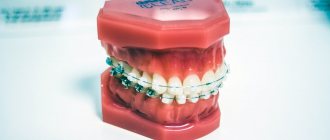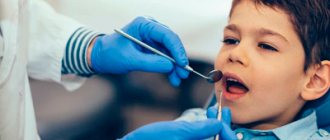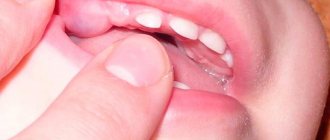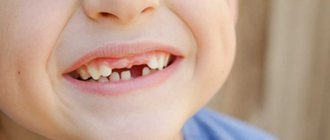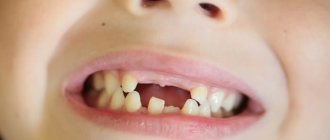Home | Can teeth straighten themselves?
The formation of dental buds occurs in the prenatal period at the earliest stages of fetal development. This process is influenced by the mother’s health and lifestyle, and genetic factors. After the birth of a child, a balanced diet and type of feeding (artificial or breastfeeding) are of great importance. With the eruption of the first tooth, it is necessary to pay attention to oral hygiene. We can talk about the final formation of the bite at the age of 12-14 years. An incorrect bite can form due to a number of reasons:
- Abnormal development of the jaws – macrogeny (enlargement of the jaw bone), microgeny (underdevelopment, reduction of the jaw bone);
- Violation of the timing of teeth change;
- Premature removal of baby teeth;
- Inadequate nasal breathing;
- Bad habits: thumb sucking, pacifiers, biting pencils and other objects;
- Unfavorable heredity.
Content:
- A competent approach to the problem
- If the very first teeth are crooked
- Causes of crooked teeth
- What to do if a tooth grows crookedly
- Do I need to straighten crooked teeth?
Seeing that a canine or incisor is “looking in the wrong direction,” parents immediately ask the question whether baby teeth can grow crooked. Knowing the correct answer to this is very important, because failure to take therapeutic measures in a timely manner can result in an unaesthetic smile in adulthood.
Are uneven baby teeth a problem?
When a baby's first teeth begin to grow, they are usually straight and close together. As the child grows, his jaw also increases in size, causing the teeth to “diverge.” Normally, the spaces between the teeth should be even. If the first teeth are uneven and unequally spaced, this may indicate that the jaw is developing asymmetrically. Does your child have uneven baby teeth? Don't think that they will become smoother with age. Instead, take your child to the pediatric dentist. Timely diagnosis and treatment will help avoid serious consequences, such as the appearance of uneven molars.
A competent approach to the problem
Dentists recommend bringing children for routine examinations to the dental clinic starting from the age of two. Already at this age, the doctor can discern the features of the developing bite and tell whether additional corrective measures will be required. If some teeth erupt very crookedly, he will tell you how they can be straightened so that in the future they will stand correctly.
Some mothers and fathers consider such careful attention to a child’s crooked baby teeth to be unnecessary. They explain their position by the fact that temporary teeth will soon fall out, and it is possible that they will be replaced by straight permanent ones.
Of course, you can hope for chance. As practice shows, a crooked baby tooth is often replaced by an equally permanent one. The doctor will conduct a diagnosis and determine whether the growth of the unit needs to be adjusted. Parents can rest assured that modern methods of preventing serious orthodontic problems do not cause pain or discomfort. Therefore, they can be safely used even when working with three-year-old children.
What methods exist for straightening teeth and correcting bites in children?
The first method of straightening teeth in children is the “classic of the genre”, something that was known back in the Soviet Union - these are plates.
What are the advantages of records (there are four of them):
- is that records are relatively cheap to make,
- the fact that children can easily brush their teeth (again, due to the fact that they are removable).
- the third advantage is that there are quite powerful mechanics for correcting the bite, because most often special screws are installed in the plates, which are unscrewed by the parents, that is, which are activated and create the force necessary either to move the teeth or to expand the size of the jaws.
- well, and another fourth plus is that they are produced quite quickly, that is, you don’t have to wait long for them - literally a few days, and the record is ready.
What are the disadvantages of records? There are also four of them:
- The first disadvantage of the plates
is that the plates are quite uncomfortable. The plate is quite bulky - accordingly, the space for the tongue is reduced. It is constantly observed that children play with records: they remove them with their tongues, play around, and so on. Therefore, they are quite inconvenient. - Second minus .
Serious. The records change the perception of taste. This is especially true for the plate on the upper jaw. The fact is that there are taste buds on the hard palate, the plate covers them, and the child, in theory, when undergoing a course of bite correction should walk with the plate constantly, removing it only to brush his teeth. It turns out that when a child eats, the food does not touch the palate, and therefore the sensation of taste changes. It's not very pleasant. - The next, third disadvantage
(I have already partially mentioned this) is that diction is impaired with records due to the fact that they are simply in the space for the tongue. Children adapt quite quickly to records in terms of diction, but still there are definitely residual phenomena, and if, say, we have a schoolchild in front of us, then this creates a lot of inconvenience, for example, from the point of view of sound pronunciation in foreign languages - where teachers are constantly fighting for pure sound pronunciation, for correct diction, and so on. In this regard, the plates are, of course, very inconvenient, and the temptation to take them off during classes and then forget to put them on is very great. - The fourth minus
. And this is also the next minus for parents and doctors, and a plus for children (this is such a plus or minus) - the ability to remove these plates! Yes, this is convenient for hygiene, but from another point of view, children are often guilty of this - when they leave parental control (for example, to school), they take off the records and put them, God willing, in some other box ( or even in your pocket), they walk around all day without the records, everything is fine, and then they put them on again in front of their parents. It turns out that the effectiveness of treatment in correcting a child’s bite in this case is reduced to zero.
Summary of records
So what can I say based on the records? If the child is disciplined, if he wears the plate well, constantly and follows all the doctor’s recommendations, then this is a very good technology, and it can solve certain problems quite quickly. The downside - from all that I have listed - is that if the child is undisciplined or, say, there is low cooperation with him, then in this case the plates are more of a torment than any kind of effectiveness.
Questions and answers about records
- But there is also a moment that even if the child does not wear it partially, it is twisted, expanded, and the parent can notice that it does not go over the teeth if you start to expand it.
- Absolutely right.
- Then see a doctor.
It turns out that there is still some impact on the child in this situation. - No. You see, the fact is that if the child does not wear the plate, then the jaw does not expand properly, as intended in the plate. That is, in this case the plate dangles, as patients sometimes say, it’s like a galosh. It no longer puts pressure on the teeth and does not fit. And in this case, of course, the doctor, for his part, tries to somehow correct it, screw it back, but often this leads to the fact that the plate has to be redone. And these are new investments, we are stalling in one place, and the problem is not being solved. Therefore, the effectiveness of the plate, if you wear it, is high, but, unfortunately, there are a lot of such “victims” who did not wear the plate, and then they come at an older age.
If the very first teeth are crooked
The first lower incisors erupt between the ages of six months and one year. They often grow in an "L" shape. This is the norm. This situation definitely does not require any treatment. By the time of complete eruption, the units are aligned and become correct.
If parents are very worried, they can speed up the process of stabilizing the position of the incisors. To do this, the baby should be given to drink from a bottle with a special tight nipple with a small hole. When using it, the baby will make more effort when sucking.
Another situation that should not worry is the even spacing between the first teeth. They disappear when the chewing units erupt. Dentists recommend paying attention only to uneven and too wide diastemas. They most often have to be closed with plates and braces.
Causes of crooked teeth
There are quite a few factors that determine the curvature of milk units. Sometimes parents are to blame for the violation, because they do not allow their grown-up child to chew solid food on their own for too long or ignore the symptoms of calcium deficiency. It also happens that the curvature is caused by the individual characteristics of the baby’s body. This is what the most common causes of curvature look like:
- hereditary predisposition;
- chronic pathologies of the nasopharynx, forcing the baby to constantly breathe through the mouth;
- speech therapy disorders not corrected in a timely manner;
- too short frenulum, anatomically large tongue;
- bad habit of sucking fingers, gnawing foreign objects;
- Bottle feeding your baby once he or she reaches one year of age.
All these are factors that contribute to the curvature of baby teeth. If the violation is obvious, there is no need to panic. The doctor will select a method that will quickly straighten the teeth. Moreover, the sooner treatment is started, the better. Therefore, there is no need to delay seeking dental care.
Measures to help prevent the development of pathology
By understanding why a child’s baby and molar teeth are coming in crookedly, you can prevent the problem from occurring at the earliest stages. To do this, you must adhere to the following preventive measures:
- establishing breastfeeding;
- following the bottle feeding technique if the baby is fed formula;
- excluding pacifiers for children over one year old;
- getting rid of bad habits;
- introducing solid foods into the diet immediately after the appearance of the first teeth;
- daily high-quality oral hygiene;
- maintaining the balance of vitamins and minerals in the child’s body;
- Regular visits to the dentist (at least once every six months) for timely detection of orthodontic problems and prescribing effective treatment.
What to do if a tooth grows crookedly
If parents see that a tooth is very crooked, there are uneven gaps between the units, they need to take the child to an appointment at the dental clinic. It is possible that their experiences are far-fetched. Then the doctor will calm you down and tell you how to properly care for your teeth so that the imaginary problem does not become a reality.
If there really is a curvature, removable orthodontic trainers will help remove it at the age of under seven years. They are a flexible silicone mouthguard. It forces the units to take the correct position. Most often it is enough to wear it only at night. But sometimes short wearing during the day is required.
Between the ages of seven and twelve years, the bite is corrected using removable plastic plates. They are made from individual casts. You can remove the mouthguard only when brushing your teeth and eating. The period of getting used to it takes from one to two weeks.
Braces are recommended for patients over 12 years of age. They are used for crooked permanent teeth. Breast units are never leveled using braces.
At what age should correction begin?
Orthodontic correction can begin at the age of 6-8 years, but at this time only removable appliances such as plates are used. Braces can be installed only after all permanent teeth have erupted. This process is usually completed by age 14. Today, you can also correct your bite using clear aligners. They are used from 16-18 years of age. It is important here that the teenager understands the importance of treatment and is motivated to complete it, aware of the importance of what is happening. Since the aligners are easy to remove, parents need to be sure that the child is actually wearing them for the required amount of time. Otherwise, it will be impossible to achieve a positive result.
Correcting overbite with braces in adults
Many people are concerned about the question: can teeth straighten themselves? As already mentioned, the process of jaw transformation ends at the age of 14 years. Teeth can also shift when third molars (wisdom teeth) erupt, which usually occurs between the ages of 18 and 25. However, in such a situation one cannot expect positive changes. In the future, the position of the teeth does not change.
For such serious disorders as progenia, prognathia, and significant crowding of teeth, treatment with a permanent brace system is indicated. Today, patients have the opportunity to choose a system made of metal, synthetic sapphire, and ceramics. The products are characterized by high aesthetics, are suitable for long-term treatment and allow you to achieve expressive aesthetic results.
How to straighten your front teeth
Aligners are best suited for straightening frontal teeth. They allow for easy rotation, extrusion, intrusion and tooth movement. They can also help eliminate crowding. To do this, teeth are separated - a small amount of enamel is removed in the proximal area (between the teeth). Due to the freed up space, the teeth are moved. Separation is a safe and painless procedure. Activators help speed up the alignment process - small composite “dots” that the doctor forms on the surface of the teeth. They serve as additional support for the system, but at the same time do not interfere with the aesthetics of the smile.
Do I need to straighten crooked teeth?
It is wrong to treat dental curvatures only from the standpoint of a violation of aesthetics. There is no need to think that the existing defect spoils the smile slightly, and therefore it is not necessary to correct it.
Incorrectly positioned teeth can also lead to more serious problems, such as poor hygiene. Then plaque will constantly accumulate in the interdental spaces. Pathogenic microorganisms will begin to actively multiply in it, which means caries will not be long in coming. If treatment is not carried out at this stage, the destructive process will spread to the deep tissues of the tooth and bone. Then removal will be required. If the milk unit is pulled out much earlier than the time when it should have fallen out on its own, its neighbors will take its place. And this is a serious malocclusion.
Another complication that crooked baby teeth lead to is uneven load on the jaw. It is fraught with abrasion of healthy teeth and disturbances in the functioning of the temporomandibular apparatus. It also negatively affects the functioning of the digestive and respiratory systems.
This is how many problems can arise due to a simple reluctance to straighten a crooked tooth. Therefore, do not delay your visit to the doctor. Take care of the health of your child's smile from early childhood.
